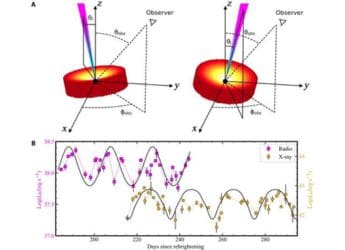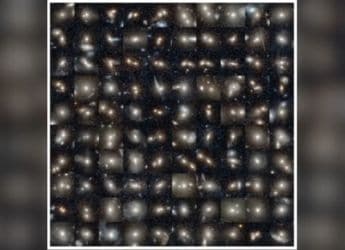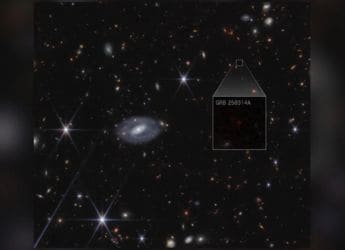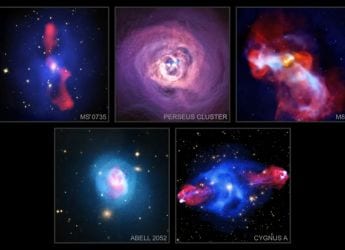- Home
- Science
- Science News
- James Webb Space Telescope Spots Rare Protostar Blasting Twin Jets Across Milky Way
James Webb Space Telescope Spots Rare Protostar Blasting Twin Jets Across Milky Way
James Webb imaged a rare protostar in Sh2-284 firing twin jets, offering new insights into how massive stars form.

Photo Credit: NASA
Sh2-284 a young massive star fires twin jets, carving a glowing nebula as it continues to grow
NASA's James Webb Space Telescope has captured an image of a baby star in the glowing nebula Sharpless 2-284 on the outskirts of the Milky Way, unleashing twin jets roughly eight light-years long. The massive protostar, around ten times the mass of the Sun, lies about 15,000 light-years from Earth. Its narrow streams of glowing gas blast through space at hundreds of thousands of miles per hour, acting like a cosmic blowtorch. These jets carve out the surrounding nebula as they plow into interstellar gas.
Massive Star Fires Twin Jets
According to Webb's observation, the infrared camera clearly captures the twin jets as long, bright ribbons stretching from opposite poles of the young star. In the image they slam into the surrounding gas, carving out the glowing Sh2-284 nebula. NASA scientists liken the scene to “a double-bladed dueling lightsaber”. Lead researcher Yu Cheng calls the outflow “spectacular” and notes jets of this size are extremely rare.
Each beam of gas races at hundreds of thousands of miles per hour, powered by material falling onto the protostar. The jets are surprisingly straight and nearly 180° apart, implying the star's disk remained steady rather than chaotic.
Scientific significance
The origin of the largest stars in the galaxy has long been a topic of discussion among astronomers. According to Webb's model of symmetric jets, massive stars form through a steady disk of gas rather than a chaotic process. At the Milky Way's outer edge, a protostar ten times the mass of the Sun is currently accumulating material to replicate early-universe conditions. A unique perspective on star formation can be gained by observing this primitive star.
Get your daily dose of tech news, reviews, and insights, in under 80 characters on Gadgets 360 Turbo. Connect with fellow tech lovers on our Forum. Follow us on X, Facebook, WhatsApp, Threads and Google News for instant updates. Catch all the action on our YouTube channel.
Related Stories
- Samsung Galaxy Unpacked 2025
- ChatGPT
- Redmi Note 14 Pro+
- iPhone 16
- Apple Vision Pro
- Oneplus 12
- OnePlus Nord CE 3 Lite 5G
- iPhone 13
- Xiaomi 14 Pro
- Oppo Find N3
- Tecno Spark Go (2023)
- Realme V30
- Best Phones Under 25000
- Samsung Galaxy S24 Series
- Cryptocurrency
- iQoo 12
- Samsung Galaxy S24 Ultra
- Giottus
- Samsung Galaxy Z Flip 5
- Apple 'Scary Fast'
- Housefull 5
- GoPro Hero 12 Black Review
- Invincible Season 2
- JioGlass
- HD Ready TV
- Laptop Under 50000
- Smartwatch Under 10000
- Latest Mobile Phones
- Compare Phones
- Redmi Note 15 5G
- Redmi Note 15 Pro 5G
- Redmi Note 15 Pro+ 5G
- Lava Play Max
- Poco C85 5G
- Honor Magic 8 Lite
- Jolla Phone
- Realme P4x 5G
- Asus ProArt P16
- MacBook Pro 14-inch (M5, 2025)
- OnePlus Pad Go 2
- Poco Pad M1
- Just Corseca Skywatch Pro
- Honor Watch X5
- Acerpure Nitro Z Series 100-inch QLED TV
- Samsung 43 Inch LED Ultra HD (4K) Smart TV (UA43UE81AFULXL)
- Asus ROG Ally
- Nintendo Switch Lite
- Haier 1.6 Ton 5 Star Inverter Split AC (HSU19G-MZAID5BN-INV)
- Haier 1.6 Ton 5 Star Inverter Split AC (HSU19G-MZAIM5BN-INV)

















